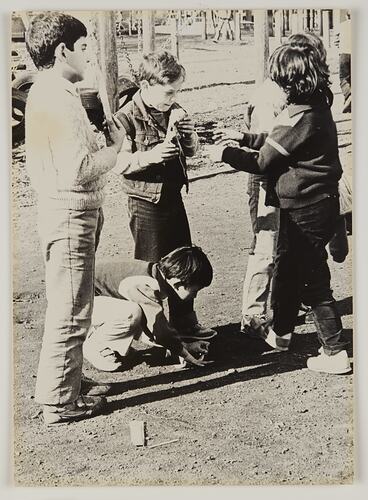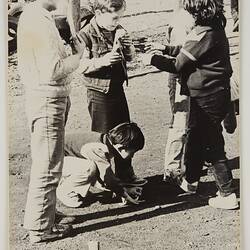No matter how or where you play marbles, rules are needed for a game to work. Marbles rules and special terms have been documented in Australia over the last 150 years.
Sir Joseph Verco recorded South Australian children's play in the 1860s. He writes that some boys would jerk their hand forward into the ring so as to get nearer their mark before releasing their taw for impact. This was denominated funnicking and directly it was noticed it raised the cry of fen funnicks or none of your funnicking and the practice had to cease as unfair. (Verco, 1860s)
Playing marbles in the 1930s, Russ Manie remembers that our rules included no fananny wacking, fudging or cribbing. Fananny wacking is pushing your hand forward as you fire. You have to keep still. You weren't allowed to crib over the line. If boys...had been scun, it meant that they had lost all their marbles. (Hope, 1984)
Pinking or drissy is a ritual for deciding who would fire/shoot first. Players threw their taws towards a predetermined line. The player whose taw landed closest to the line fired first. (Dorothy Howard, 1960)
At an inner city Melbourne primary school in 1984, playing for toys meant the player who lost the game didn't have to give their marble to the winner. Playing for reals meant the winner kept the loser's marble. A plong was a hard hit in which two marbles ended up a long way apart. In Vietnam this was measured by three hand spans.
In some games like Triangles, players were allowed to make either one, two or three mistakes before they lost their turn. This rule was agreed on before the game started. (Russell, 1986)
Research for the You're It exhibition in 1988 at Alphington Primary School found the 'no cribbing' rule was still in force but it was called no fenudge. This school had two rules to ward off cheating. No chix meant that if you were losing you mustn't run off before the game finished. No clears meant you were not allowed to the clear the ground in front of your taw.
Firing styles
In the 1930s, Russ Manie had two firing styles: One was called Funny Knuckle and you wore your thumb nail out on that. Your thumb was used to flip the alley. Then there was Fast Knuckle, fired from the joint of the thumb. Some boys were deadly accurate. They were superior. We fired either from the knee or squatting down using our hand as a bridge. Fingers were used as a fork, like a bridge in billiards. (Hope, 1984)
In Melbourne in the 1980s, two quite different flicking styles were used in school playgrounds where children came from diverse cultural backgrounds. One used the thumb nail to flick the marble as described by Russ Manie. This was called the Australian flick to distinguish it from the Chinese flick (also called the Asian flick). Some children of Turkish heritage called their flicking style the Turkish flick, which was the same as the Australian flick.
The second flick, the Chinese flick, also called the Asian flick, used the crook of the middle finger with the marble held in place with the thumb and third finger of the other hand. The thumb of the flicking hand was kept on the ground for balance and the marble was flicked straight through the air to its target. This firing style was said to be faster and more accurate than the Australian flick so children from all cultural backgrounds learnt to use it. (Russell, 1986; Australian Children's Folklore Collection, Student work)
References
Australian Children's Folklore Collection (ACFC): Dorothy Howard Collection (1954-5); You're It exhibition (1989); Play and Friendships in a Multicultural Playground project (1986); Student work, Institute of Early Childhood Development (unpublished, 1980s).
Haagen, C. (1994). Bush Toys: Aboriginal Children at Play. Canberra: Aboriginal Studies Press.
Hope, C. (1984). Themes From the Playground. Melbourne. Thomas Nelson.
Howard, D. (1960). Marble Games of Australian Children, London. Offprint from Folklore, Volume 7, September.
Marshall, A. (2010). I Can Jump Puddles, Penguin Group (Australia) reprint, originally published 1955.
Russell, H. (1986). Play and Friendships in a Multicultural Playground, Australian Children's Folklore Publication, Institute of Early Childhood Development, Melbourne.
Verco, J. (1860s). Early Memories (unpublished manuscript). South Australia. Mortlock Library.
More Information
-
Keywords
-
Localities
-
Authors
-
Article types



